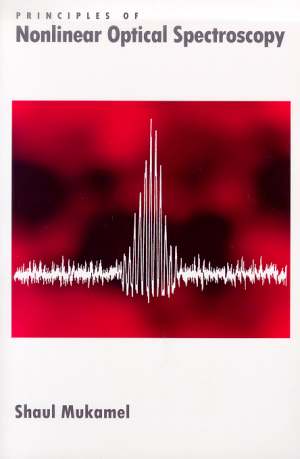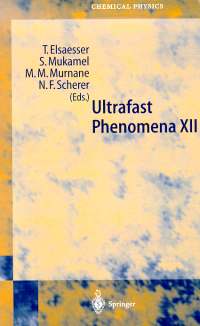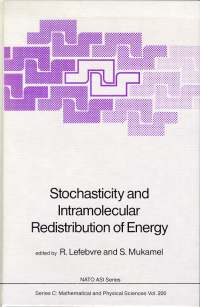











Books

|
Principles of Nonlinear Optics and SpectroscopyOxford University Press (1995)Paperback (1999) Order from amazon.com |
Table of Contents
- Introduction
- Quantum Dynamics in Hilbert Space
- The Density Operator and Quantum Dynamics in Liouville Space
- Quantum Electrodynamics, Optical Polarization, and Nonlinear Spectroscopy
- Nonlinear Response Functions and Optical Susceptibilities
- The Optical Response Functions of a Multilevel System with Relaxation
- Semiclassical Simulation of the Optical Response Functions
- Cumulant Expansion and the Multimode Brownian Oscillator Model
- Spontaneous-Raman and Coherent-Raman Spectroscopy
- Selective Elimination of Inhomogeneous Broadening; Photon Echoes
- Resonant Gratings, Pump-Probe, and Hole Burning Spectroscopy
- Wavepacket Dynamics in Liouville Space; The Wigner Representation
- Wavepacket Analysis of Nonimpulsive Measurements
- Off-Resonance Raman Scattering
- Polarization Spectroscopy; Birefringence and Dichroism
- Nonlinear Response of Molecular Assemblies; The Local-Field Approximation
- Many Body and Cooperative Effects in the Nonlinear Response
Reviews

Press release by Oxford University Press:
"Brilliantly ties fundamental principles to experiment with an elegant formalism..."Features:
Graham R. Fleming, Dept. of Chemistry and James Franck Institute, University of Chicago.
The extraordinary advances in laser technology-particularly ultrafast laser technology-have opened up a new era in spectroscopic measurement. Experiments with previously undreamt of precision, time resolution and complexity are being carried out. In particular, many multi-phase spectroscopies, previously possible only in the magnetic resonance field are becoming routine in the optical region. But molecules have more complex Hamiltonians than spin systems and a straightforward transfer of concepts from the magnetic resonance field to optical spectroscopy is often inappropriate.Mukamel has developed a powerful and intuitively satisfying description of dynamical nonlinear spectroscopy which allows the enormous variety of nonlinear spectroscopies to be described and analyzed on a common footing. His unified description is based on a density matrix formalism-it shows what is measurable and what isn't, how different measurements relate (of critical important in negotiating the minefield of time and frequency domain comparison) and how microscopic descriptions of the system and its surroundings can be incorporated into the prescription for the experimental signal.
Mukamel has now collected his work into a monograph which is sorely needed and will influence workers in nonlinear spectroscopy for many years to come. At first sight his work is rather forbidding and a key feature of this book is that the theoretical tools required to master the formalism are laid out in Chapters 2 and 3. A student who has mastered graduate quantum mechanics should be able to cope with this material.
After and introduction to radiation-matter interaction and some elementary quantum electrodynmaics, the book proceeds to introduce the response function formalism which lies at the heart of the calculation of linear and nonlinear optical signals. Extensive use is made of double-sided Feynman diagrams which aid considerably in the developing intuition about the information content of the various types of resonant and non-resonant spectroscopy described.
Although many of the methods described in this book are very general, Chapters 7 and 8 provide concrete physical models, such as the Brownian oscillator model for the calculation of response functions. The following six chapters are devoted to a survey of application sof the response function formalism to a wide range of time and frequency domain measurements, both resonant and non-resonant. Of particular value are the incisive analyses of spontaneous and coherent emission spectroscopies, photon echoes and the discussion of experiments involving phase-locked pulses. The text then introduces wavepacket analysis allowing for finite optical pulse duration. This section of the book concludes with a chapter on off-resonance Raman scattering and on the role of optical polarization in nonlinear spectroscopy.
The final two chapters extend the theoretical approach to systems such as molecular aggregates and semiconductors where the interactions between the particles cannot be neglected. Chapter16 discusses a local field approach and Chapter 17 extends the discussion to include many-body and cooperative effects.
The book is likely to be essential reading for workers in a wide variety of fields impinging on the dynamics of complex, condensed phase systems. The book will be important both for the design of new experiments as well as their analysis. Mukamel is to be congratulated on this superb book, and his publisher deserves credit for keeping the price within the reach of graduate students and their professors.

Douwe A. Wiersma, Dept. of Chemistry, Ultrafast Laser and Spectroscopy Lab, Univ. of Groningen, Nijenborgh, The Netherlands. Appeared in Optics & Photonics News, Vol. 9, No. 1 (pg. 53).
Shaul Mukamel's book is a must for anyone seriously interested in condensed and gas phase optical dynamics. It is largely based on material drawn from over 300 publications by the author, and presents a monumental effort to provide a unifying description of the many seemingly unconnected nonlinear optical spectroscopies. The book is well-organized and contains many referecnces and an extensive index. It is ideal for graduate and post-doctorate students. It is also invaluable for senior staff wishing to become educated on the theoretical state-of-the-art in this field. What also makes the book attractive is that it shows results of key experiments in teh field. The book appears at the right time when, to paraphrase Wayne Knox (W.H.Knox, "The revolution in femtosecond near-infrared pulse generation," Opt. Phot. News 3 (5), 10 1992) , femtosecond lasers are as ubiquitous as 9 V batteries, and there is a definite need to interpret results from femtosecond pectroscopies at a more advanced level than was done in the past.
In 17 chapters covering 523 pages, Mukamel discusses the complete foundation of nonlinear optical spectroscopy in great detail. One of the important concepts thoroughly discussed in the book is the density matrix description of optical dynamics in Liouville space. While for many students this chapter may form a potential barrier-as the author puts it-the time invested pays off directly in the rest of the book. For instance, the Liouville space formulation in terms of the double-sided Feynman diagrams allows for an immediate connection between well-known techniques such as pump-probe spectroscopy, transient grating, and photon echo. Another important asset of the Liouville space formulation is that it deals with electronic and vibrational coherence in a very transparent manner so that techniques like photon echo no longer seem so esoteric.
An important theme of the book is that optical dynamics in solvents and solutions cannot be described in terms of a Block-like dynamical model, which characterizes these dynamics in terms of two constants: T1, the population relaxation time constant, and T2, the optical dephasing time constant. In the liquid state, dynamics are captured in terms of correlation functions, or even better spectral densities. In this context the multimode Brownian oscillator (MBO) model plays an important role to provide a physical basis for the correlation functions. It is also shown that the stochastic modulation (Kubo) model and the Bloch model are limiting cases of the MBO model. Several chapters are devoted to a thorough discussion of the information content of spontaneous and coherent Raman scattering, photon echo, transient grating, polarization and hole-burning spectroscopies, and how these spectroscopies are related.
With femtosecond pulses, it is a rule rather than an exception that wave packet dynamics play a role in the experiments. Mukamel discusses this effect in great detail in the context of the Wigner representation. For ultrafast pump-probe experiments in the gas phase where wave packet dynamics plays a dominant role, the doorway-window picture is introduced and applied to the seminal experiments of the Zewail group on ICN.
The book ends with two chapters on molecular assemblies. Many-body and cooperative effects on the nonlinear response of these materials are discussed in detail. These chapters will certainly stimulated further interest in the linear and nonlinear optical properties of nanostructures.
Stimulated by the recent developments in ultrafast laser technology, progress in the field of nonlinear optical spectroscopy occurs at an increasing pace. Because of Mukamel's book there is hope that scientists worldwide will speak a common language, easing communication and stimulating cooperation. Principles of Nonlinear Optical Spectroscopy also opens the door to a deeper understanding of the relation between optical dynamics and chemical reactivity.
The following is an excerpt from a message written by Dr. V. A. Kuz'menko (Troitsk Institute for Innovation and Fusion Research, Troitsk, Moscow region, 142190, Russia Federation) about Nonlinear Optics and Spectroscopy:
The term "photon echo" supposes the existence of a rephasing process in experiments, which has the same speed as a dephasing process, but directed due to molecule-photon interaction in the opposite side. Phyiscally it manifests as the equality of the time delay between the last two pulses of radiation and between the first two pulses of radiation (both for the two-pulse and for the three-pulse echoes). As you know, in femtosecond experiments this main sign is absent. Instead of the rephasing process (backward dephasing), we, obviously, have only the processes of vibrational and rotational alignment. This is sufficient for appearance of a directed superfluorescence as a result of a four photon (wave) mixing process, but insufficient for having a right to call the effect by "photon echo" term.
The main argument of advocates of using the term "photon echo" in femtosecond experiments is the reference on the authority of the founders (Mukamel, Bloch). This situation looks like very similar to lose, which existed many years ago, when all authority people round the world believed that the Earth is flat and it is lying on three fish. There existed few opponents, whihc believed, that the Earth is a round and it is whirled. Such pluralism had the high cost for some of them. However, later the terminology in this field had been substantially changed.
The following appeared in Analytical Chemistry, 68 680A - 681A (1996):
"Review of the Principles of Nonlinear Optical Spectroscopy" By John C. Wright, Department of Chemistry, University of Wisconsin
This book is written by the leading theoretician in the field of nonlinear optical spectroscopy in condensed phase systems. It is quite complete, detailed, and mathematically rich. Reading the book is challenging because it is written for a specialist in theoretical condensed phased nonlinear spectroscopy. It would be of little use to almost all analytical chemists. Nevertheless, the quality of the book is exceptionally high and it lays the theoretical foundations for some of the most novel and exciting spectroscopic methods. Mukamel sets the lofty goal of providing a unified theoretical framework for all spectroscopic methods including the ultrafast time-domain methods that rely on phase relationships between matter and the electromagnetic fields. He achieves his goals admirably but few analytical chemists would find the framework relevant to their interests.
The book begins with a first principles description of how the quantum dynamics in a Hilbert space can be described by density matrix methods in Liousville space. These methods form the basis for all later treatments in the book. The book continues wit a development of the quantized electromagnetic field, matter's optical response functions, and the linear and nonlinear interactions between fields and matter that control thew spectroscopy. The treatment includes details for how different theoretical approaches can be used to approximate and simulate the complex effects. It also includes a microscopic theory that defines homogenous and inhomogeneous broadening in condensed phase systems. The density matrix framework uses optical response functions that make natural connections between the time and frequency behaviors that are characteristic of the spectroscopic methods at the frontier of the field. Most chapters have appendices that treat particular aspects of a section in a more tutorial fashion.
After building the theoretical tools, Mukamel devotes the next part of the book to applying the methods to a wide range of spectroscopies including fluorescence, Raman, coherent Raman, photo echo, quantum beats, resonant grating methods, and polarization spectroscopies. He introduces wavepacket representations for the material dynamics that describe the new impulsive methods of spectroscopy and he shows the relationship that these representations have more traditional methods. The book concludes with a treatment of many body effects which become more important when the spectroscopic system requires interacting chromophores.
This book is mandatory for workers at the frontier of condensed phase nonlinear spectroscopy. The author is uniquely capable of putting this book together. The book is clearly a work of love. It is complete, deep, and authoritative. The writing has clarity and coherence expected for a single author work. It is not appropriate for nonspecialists because the treatment is too advanced and not relevant for the spectroscopies of the present.
Principles of Nonlinear Optical Spectroscopy
Book Review by V. S. Letokhov.

|
Ultrafast Phenomena XIISpringer (2000)Order from amazon.com |
Table of Contents
- Coherent Control
- Lasers for Ultrashort Pulses
- Pulse Characterization, Shaping and Measurement Techniques
- THz Generation and Measurement
- Imaging and Microscopy
- X-Ray Generation and Diffraction, Higher Harmonics, High Intensity Physics
- Ultrafast Dynamics of Atoms, Molecules and Clusters in the Gas Phase
- Ultrafast Processes in Semiconductors
- Isolators, Metals and Superconductors
- Electron Dynamics and Charge Transfer at Interfaces and in Liquids
- Two-Dimensional Spectroscopy
- Dynamics in Liquids
- Polymers, Aggregates, and Macromolecular Systems
- Ultrafast Chemistry
- Biology
Preface
Thomas Elsaesser, Shaul Mukamel, Margaret Murnane, Norbert Scherer This volume is a collection of papers presented at the Twelfth International Conference on Ultrafast Phenomena held at Charleston, SC, from July 9 to 13, 2000. The Ultrafast Phenomena conferences are held every two years and provide a forum for discussion of the latest results in ultrafast optics and their applications in science and engineering. A total of more than 200 papers was presented, reporting progress in the technology of generating and characterizing ultrashort pulses, including new techniques for shortening the duration of laser pulses, for stabilizing their absolute phase, and for improving tunability over broad wavelength ranges, output powers and peak intensities. Ultrafast spectroscopy, including techniques like time-resolved X-ray diffraction and two-dimensional spectroscopy, continues to give new insights into fundamental processes in physics, chemistry and biology. Control and optimization of the outcome of ultrafast techniques, for instance in material diagnostics and processing and in imaging and microscopy. The enthusiasm of the participants, among them many students, the high quality of the papers and the nice conference site made the conference successful and pleasant.Many people contributed to the success of the conference. The members of the international program committee reviewed the submissions and put the final program together. The staff of the Optical Society of America deserves special thanks for making the meeting arrangements and running the meeting smoothly. We would like to thank the Optical Society of America for sponsorship, and also acknowledge support from Coherent, Lucent Technologies, Newport, Positive Light, Spectra PHysics Lasers and Thorlabs.

|
Stochasticity and Intramolecular Redistribution of EnergyNATO ASI Series (1987)Order from amazon.com |
Preface
This volume contains the invited papers presented at the NATO Advanced Research Workshop on "Stochacisty and Intramolecular Redistribution of Energy" held in Orsay (France) from June 23 to July 3, 1986. The workshop brought together leading researchers involved in the experimental and the theoretical studies of vibrational energy flow and relaxation in activated polyatomic molecules. The recent experimental developments in this area include the study of high resolution (frequency domain) and ultrafast (time domain) spectroscopic techniques. On the theoretical side the introduction of statistical methods (random matrix theory, reduced equations of motion) and efficient numerical algorithms provide an adequate framework for the interpretation of vibrational dynamics in large polyatomic molecules. Classical, semiclassical and quantum calculations on simple model systems show the existence of regular and chaotic regions in the phase space. The articles in this volume provide an updated review of the current status of experimental studies and the relevance of the recent theoretical developments to their interpretation.We wish to thank the organizations which made this workshop possible. NATO provided the basic grants. We acknowledge the essential contributions of the late Sr. Mario di Lullo in providing pertinent advice. The generous support of the U.S. Air Force Office of Scientific Research, the U.S. Navy Research Office and the Exxon Corporation made it possible to organize the planning meeting for this workshop which was held in Rochester, N.Y., October 3-5, 1985. Financial support was awarded by CECAM to facilitate the participation of European Colleagues belonging to the CECAM member countries. Dr. Carl Moser, Director of CECAM helped us in many ways, in particular in providing the site for the meeting. Madame M. A. Duchassing has been very efficient in managing the practical aspects of the meeting and of the preparation of the proceedings.
|
Roland Lefebvre
Labortoire de Phophysique Moleculaire du CNRS Orsay, France |
Shaul Mukamel
Department of Chemistry University of Rochester, New York, U.S.A. |
Web design by Ronen Mukamel.